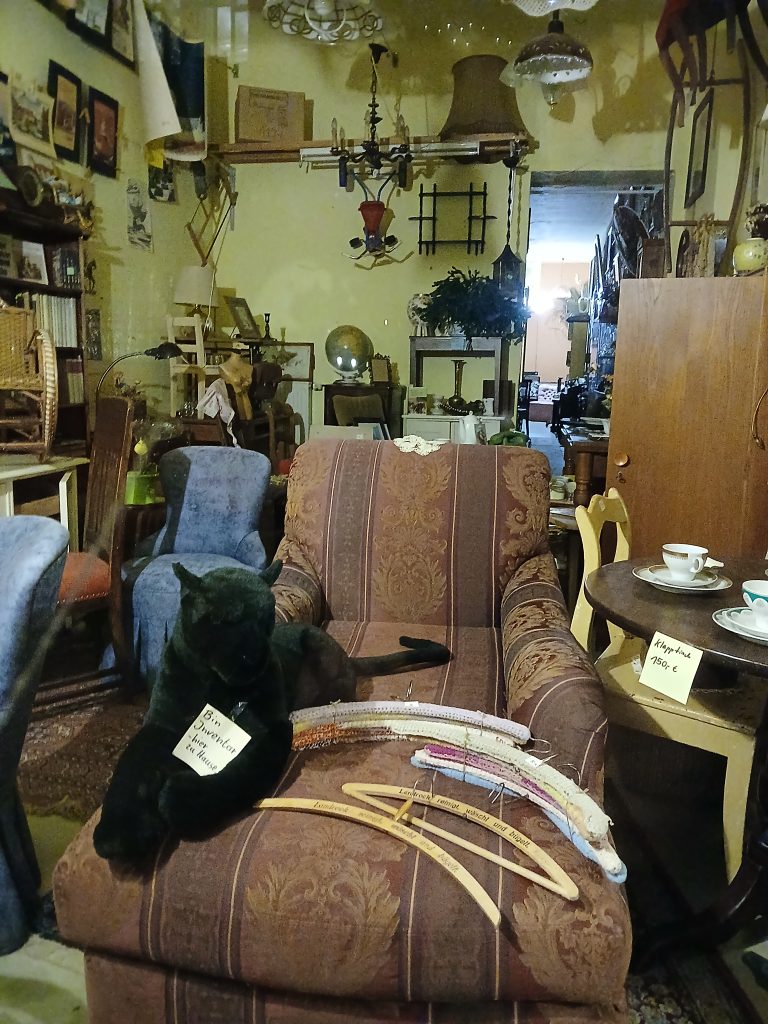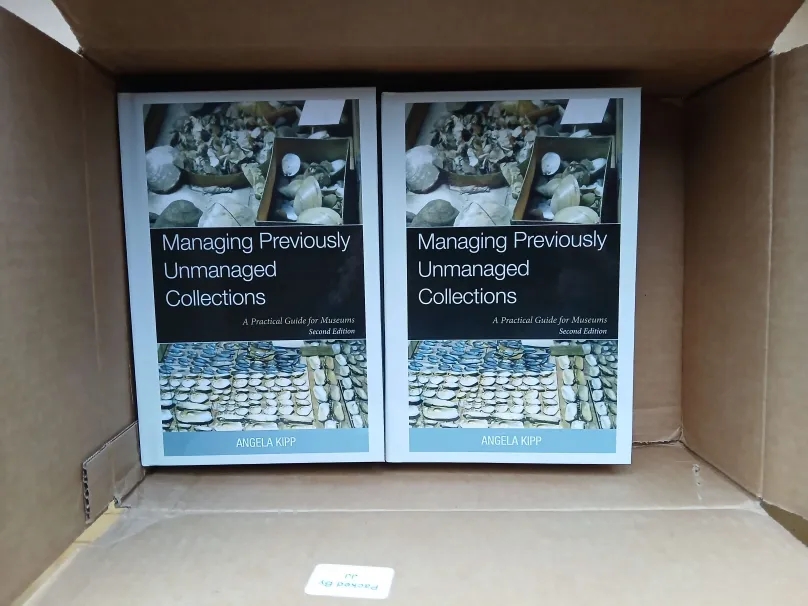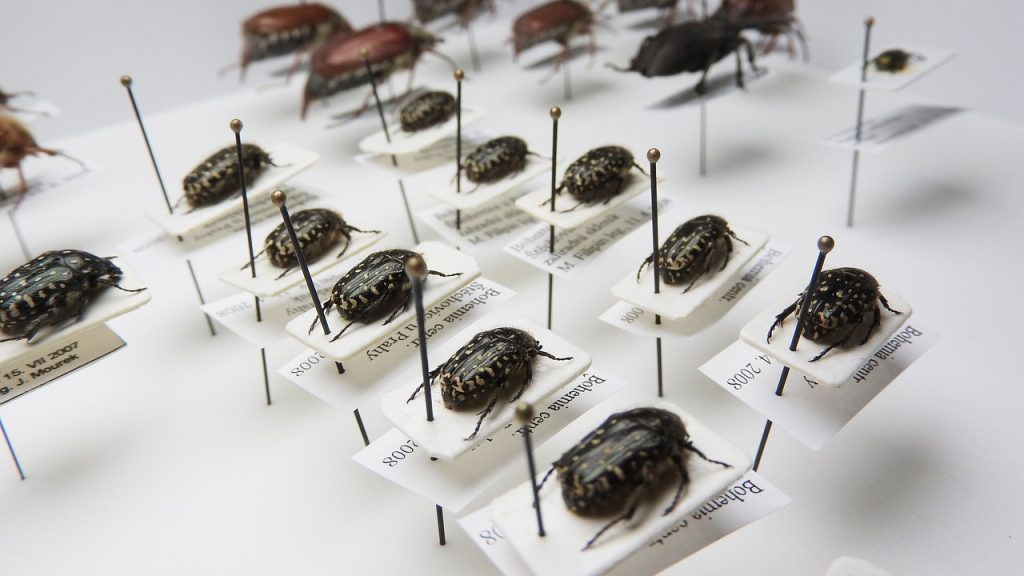This article was written for and first published in the Summer 2025 Newsletter of the Registrars Committee Western Region: https://rcwr.org/newsletters/
Usually, you find me writing about the real-world messes in our collections. Crammed stores. Decaying garments. Surprise findings in abandoned offices of your predecessor. But today, I want to write about another kind of mess: the information that was recorded – or wasn’t recorded – in your database.

You don’t have a database? Then, this article will help you prepare for the time you are getting one. It may even help you in deciding what system to chose.
The Problem
Sometimes, the mess in your database is even bigger than the mess in your storage. Do any of those sound familiar to you?
- The same information was entered in different fields, depending on who did it.
- A lot of records are only partly filled and the information contradicts the paperwork.
- Some objects have more than one record while others have none.
- Data is entered inconsistently, so you have “pipe wrench”, “wrench, pipe”, “multigrip pliers”, and “water pump pliers” and they all refer to the same kind of tool.
- Typos and inconsistent data entry make it impossible to get exact results when you search your database.
It is tempting to just correct those as you go, while you are working with the objects and I am not saying that this is a bad idea. But if you really want to make progress and getting your database into an overall better state you need a more strategic approach to it.
The problem: While you are silently fixing all the inconsistent data entries, someone else may be doing the next messy one. You first of all should determine how you want the fields to be used. You might think you have a clear idea about this, but have you, really? And have you put that into written form?
First Step: What should go where and how?
Your first step is not about fixing what is in there, it is about making sure that your database is used exactly the way you want it. For that you are creating a document that lists all the fields you have and how you want them to be used.
Be precise. “A description of the object” for the free text field “Description” will let you end up from vague entries like “Bridal gown” to a two-page description on the history of bridal gowns copied over from Wikipedia. So, formulate how you want your description to be.
Example: Object Description
“The first sentence should state what type of object it is, the main color, and important characteristics. Think of it as a way you would describe it to someone who has to look for it in the storage but doesn’t have a photo. This might be followed by a couple of sentences about the characteristics of the individual piece that makes it different from another object of the same type. Think of things like an unusual ornament, a tear, or a large stain. The purpose of this field is to make sure we can identify this individual object without doubt.”
Also make clear when information doesn’t belong in the “Description” but in other fields in your database, for example:
“Analysis of the object condition belongs in the “Condition” field. Websites about this type of object belong in the “Web links” field. Mentioning of this object in exhibition catalogs belong in the “Associated Catalogs” field. Mentioning in literature should go into the “Bibliography” field. Remarks on the provenance and previous owners go into the “Object history” field.”
Example: Terms from Controlled Vocabularies
If you are using a field where you want the entry to be taken from a controlled vocabulary, for some fields it might be enough to write “pick the correct classification from the drop-down menu”.
Others might be more complex so you need to add more guidance. “Only use terms from Nomenclature” might be at least accompanied with a link to the website https://page.nomenclature.info/ and a few examples.
If you want your information to be picked from an even more complex source, for example Getty’s Art & Architecture Thesaurus for the material, a “use only terms from the AAT” by far isn’t enough. “This term is about documenting what the object is made of. Therefore, it should be taken from the ‘materials by composition’ branch of the Materials facet of the AAT.” Provide examples, so, whoever is using your document in the future knows what your idea was and how to do a correct entry.
Guiding principle: But can I find it?
Your guiding principle when thinking about how to add your data is how you are going to search for it. This will depend on clean data entry on the one hand but also on which search functionalities your database offers. Wordy entries in free text fields often result in a lot of irrelevant search results. By keeping those entries concise and compartmentalizing information in different fields you can search more precisely – if your database offers the possibility to search for the information in those fields separately.
So, with all the fields you are writing down, always think about how “future you” will be able to look that information up. It will help a lot with making sure you are not missing something important.
Second Step: But does it work like that?
After you have written all that, put yourself to the test. Catalog a few objects. 10-20 objects are a good testing sample. Make sure that they are from a large variety of objects. Documenting 10 plates will get you nowhere. Documenting a plate, a dress, a toy, a tool, a radio, and a taxidermied badger will give you a lot of variety. Your collections policy will help you pick a good sample. All objects that could potentially end up in your collection should be easy to catalog with the guideline you are creating.
While cataloging, you will notice that you have missed some fields and some aren’t fitting for all cases. Perhaps you need to use different ones. Perhaps you need to add new ones if your database allows for it. Perhaps you just have to specify how to enter information in the same field differently for some object groups.
Adjust and share
Make adjustments to your document and/or your database so you can really catalog everything that might come into your collection. Once you are satisfied, share the document, that you might now call a “cataloging guideline” or “documentation help file” with everybody who uses the database, not just those who are doing the cataloging. It will help people who only use the database for searching know where they can find the relevant information.
But I don’t have a database
If you don’t have a database yet but just an assortment of excel spreadsheets and/or index cards, writing such a guideline and doing a few tests in an excel spreadsheet that contains the fields you have in mind will help you determine what your new system needs to be capable of. Furthermore, you can use this spreadsheet for documenting your collection now according to your guideline and later you have that data ready to import into your new system.
Now onward to tackle the mess!
Once you are at this point you have achieved something amazing: from now on, whatever is cataloged in your database will get a clean, easy to retrieve record. Sometimes, there might be slight adaptions to the guideline necessary, but by and large everybody knows how data should be entered and if you find it isn’t, you do have your document to point them to how it is done correctly. Introducing new colleagues, no matter if paid or volunteers, to cataloging in your institution will get much easier.
Now you can work on getting the rest of the database in better state.
What kind of mess do you have?
Not all messes are created equal. Sometimes the core of the records is okay, they only need some adjustments and corrections here and there. Others are so bad that the only thing you can do is to quarantine those records in an area of your database (for example by moving them to a separate department, marking them with a checkbox, or giving them a special classification like “legacy record”) where you can look them up as a reference but do new, clean records for all your objects.
Creating new records for old stuff
If the latter is your case, you now have your guideline to follow through. You might want to check back in your “legacy records” if there is any information you might have missed. Sometimes there are hints to donors you can’t find in the paperwork. Make sure your new record notes this as “according to old record #…” so it is clear where the information comes from and that it probably has to be verified. Some systems allow to link to the old record and it might be a smart idea to do that.
Improving existing records one step at a time
If you decide that your existing records aren’t too bad overall, they just need to be corrected here and there, you need to break down this task down into manageable steps. A lot of database messes were created because someone started the work with good intentions but then couldn’t follow through and someone else picked up without any idea what their predecessor did or had in mind.
Knowing that, you will of course create a document with your database improvement strategy so if you have to leave off for some reason whoever comes after you knows what you did and why you did it.
Often, it is easiest to focus on one single field and correct that throughout the database than trying to rectify all the fields in one record at once. The repetitiveness of the task helps with speeding it up. For example, take all the tools and make sure their records show the right term in the material thesaurus, usually “metal” or “wood”, sometimes both. Then move on to the household items and do the same. Or stay with the tools, but this time, you are rectifying the classifications, so the “gooseneck chisel”, “chisel, carving”, “gouge”, and “pick” can all be found under “chisel” and get sub-classifications depending on their use or form. In no time you will have become an expert in the different types of chisels, so you get much faster in classifying them.
Involving Interns and Volunteers
It is easy to see how some of this work can be delegated to dedicated volunteers or interns. If they have good attention to detail they should be well able to take over some of those corrections. And since they are only correcting one area of an object record in a defined set of objects at a time, the results are much easier to check than if you would have asked them to do a whole new record for an object.
Do paperwork and database match?
Just like you went through material and classification, one step will involve going through your paperwork and making sure that everything you have a Deed of Gift for is recorded as gift and everything you have an invoice for is recorded as purchase. Again, you work in steps that make sense, in this case perhaps you go folder by folder or year by year, depending how your files are organized.
You might end up with a lot of object records you don’t have paperwork for and on the other hand paperwork that doesn’t seem to match anything you find in your storage. Make sure your database has a field for noting that, too. And of course, what should be recorded how in it becomes part fo your cataloging guideline.
Ultimate Goal: The Treasure Trove
Your ultimate goal is that your database becomes your reliable friend. If everything else is messy, your database is the place where you have a tidy record that tells you what you know about the object – and sometimes what you don’t know. It will become your point of reference while working on improving your collection in the physical world.
Angela Kipp































